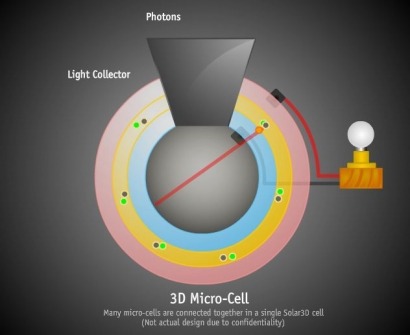
On Monday, Solar3D Inc, developer of a three-dimensional solar cell technology, unveiled what it says is the most compelling argument in favor of its product -- "revolutionary" cost benefits that it says will reduce investment payback and make solar power affordable for millions of people.
According to Jim Nelson, CEO of Solar3D, the cost savings come from two very important features: First, is a conversion efficiency of 25 percent using low cost silicon; Second, is an integrated wide-angle light collection surface that grabs light from a wider range of angles.
Unlike conventional solar cells where sunlight passes through one time, Solar3D's technology design uses a myriad of 3D micro-cells that trap sunlight inside photovoltaic structures where photons bounce around until they are all converted into electricity.
The key features of the design are:
Light Collectors – An array of light collecting elements to guide all incident sunlight into a matching array of highly optimized 3D micro-photovoltaic structures.
3D Photovoltaic Structure – A multi-facetted 3D photovoltaic structure where photons can bounce off many surfaces until all photons that can be absorbed by the material are absorbed.
Thin Absorbing Regions – The 3D photovoltaic structure is fabricated with very thin absorbing regions and designed to enhance charge carrier separation. Therefore, electron-hole pairs will travel short distances before reaching a contact wire where they will be quickly extracted to produce current.
Below Surface Contacts –This approach allows the 3D solar cells to trap and utilize nearly 100 percent of the incident light, the company said.
"Wide-angle collection allows our solar cell to collect light more effectively early and late in the day, as well as in the winter months. The result is that our 3D solar cell can deliver 200 percent more power output than conventional solar cells," Nelson said.
As a result, the company says its reduced the time for achieving a 100 percent return on investment from the traditionally expected 10-to-15 years to six to nine years.
"That makes the purchase decision more like buying a car rather than a house," Nelson said. "This is the kind of economics that will open the floodgates for mass affordability and consumption of solar panels."
For additional information:

